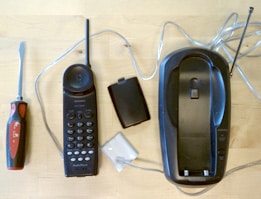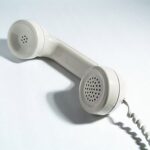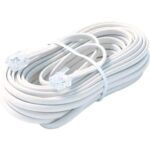This is a helpful DIY guide on how to handle phone problems and perform repairs, which includes ringing problems and how to eliminate static and interference.
If one (or more) of your phones does not work, before doing anything else, make sure every phone on the line is plugged solidly into its module and that each phone wire is plugged snugly into its phone.
To isolate the problem, one at a time, unplug each phone in the house from its module and then test to see whether any of the other phones work. If you find that unplugging one of the phones from its module makes all of the other phones work, the problem is with that phone or–most likely–its cord or module.
Is the problem with a portable phone? Some portable handsets have a static discharge protection circuit. When you walk across a carpet holding one, you may build up enough static electricity to cause the phone to turn off. If this happens, turn the handset off for a few seconds, and then try it again. Low batteries can also cause the handset to stop working, though this is usually not sudden. Recharge the handset. If that doesn’t work, replace the batteries. Rechargeable batteries are usually located behind a removable door on the handset. Disconnect the batteries, take them to a consumer electronics store, and buy replacements.
If one hard-wired phone works but another doesn’t, plug the working phone into the dead phone’s modular wall outlet. If it works, assume the problem is with the dead telephone. Try plugging the dead phone into a working outlet. If it works there, its cord or modular plug may be making a poor connection with the first modular receptacle. Switch cords with the working phone, and try again. If it works, replace the cord.
If none of the phones are working, a good first step for diagnosing the root of almost any problem is to try another telephone and/or telephone cord in the phone receptacle to see if it works. If the replacement telephone works, the problem is with the telephone, its wire, or the connection at the phone receptacle.
Try replacing the phone cord with a working cord to see whether that makes a difference. Next, remove one of the handsets before working on the phone wiring to insure that higher ringing voltage will not shock you. Do not work on your own phone lines if you have a pacemaker.
Open up the phone receptacle and look for disconnected wires–ones that have insulation stripped from their ends but are not connected to terminals. If you don’t find any, buy and install a new modular phone outlet.
If you can’t isolate the problem or get any of the phones to work by exchanging phones and cords, report the problem to your phone company from a neighbor’s house or another phone. There may be a problem with the phone lines that serve your house. If this is the problem, getting it fixed should be free—it’s just a matter of waiting for the repair.
Troubleshooting the wiring inside your home can be tricky, depending upon your level of do-it-yourself experience. Many home phone service companies offer a monthly insurance plan that covers wire and phone jack problems—they charge a very small fee for this. If you have a fairly complex system, with old wires or several jacks, or if you don’t want to hassle with trying to solve your own phone problems, such a plan is well worth the price. Call your telephone company’s business office to inquire about this type of service.
Phone Ringing Problems
If your phone rings and seems to work but one party cannot be heard by the other, the problem is often the result of a defective handset cord. You can test this very quickly by removing the handset cord and switching it with a cord that you know works. If that solves the problem, replace the cord with a new one.
If this problem is occurring with an electronic phone handset, check your owner’s manual–there may be an audio volume control or a mute button causing the problem.
If your home phone has a dial tone but does not ring, adjust the ringer loudness. The location of this adjustment depends on the particular phone. In the case of older land-line phones, it is a slider on the bottom of the phone. In the case of newer electronic phones, it is a volume control accessed through the dial pad or menu on the phone–you may need your phone’s instruction manual to sort this out.
Also check to see if there is a switch for turning off the ringer, and–if there is– turn it on. In some cases, if you connect more than five phones to a given line, they won’t ring properly. If this is your situation, you may have to disconnect one or more phones, or at least turn their ringers off to get the ringer working on a particular phone.
Reducing Static & Interference
Each frequency band can be subdivided into different increments, or channels. For example, while talking on a handset using a 900-megahertz frequency, the base searches for a pair of frequencies (channels) within that range that is not already in use to talk to the handset. This allows the base to search, which allows more discovery of frequencies that will not be interfered with, thus providing better sound quality.
In cordless phones, interference is most likely static. Interference occurs most often with 2.4-gigahertz phones, whether digital or analog, though some have features to minimize conflicts. Interference occurs because cordless phones, home networks, Bluetooth devices, and baby monitors share the 2.4-gigahertz radio frequency bands.
The following tips may help if you are at your wit’s end with the phone you have just purchased:
• Before returning a 2.4-gigahertz analog phone, make sure to try the phone in a location other than the kitchen. Kitchens are not good locations for analog phones on this frequency because they can pick up interference from an operating microwave oven.
• Try changing the channel. Usually, it’s easy—you just push a button or slide a switch.
• When you have two wireless devices that are conflicting, causing interference, try to keep those two devices as far away from each other as possible.








 Don Vandervort writes or edits every article at HomeTips. Don has:
Don Vandervort writes or edits every article at HomeTips. Don has:



